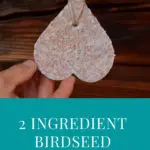
Edible ornaments for birds? Yes, you read that right. Currently you are about to embark on a tutorial on how to make bird cookies. And healthy ones at that.
There are several reasons one might choose to feed birds in winter:
- to provide them with extra calories when food sources are limited or depleted
- access to extra nutrients gives birds the chance for a more successful mating season come springtime
- everyone needs food to stay warm, including predators (even cats) that may have a diet including the occasional bird – give birds the energy they need to be able to fly away
It is true though, that often we simply want to feed birds because it is fun to look out the window and watch their amusing antics.
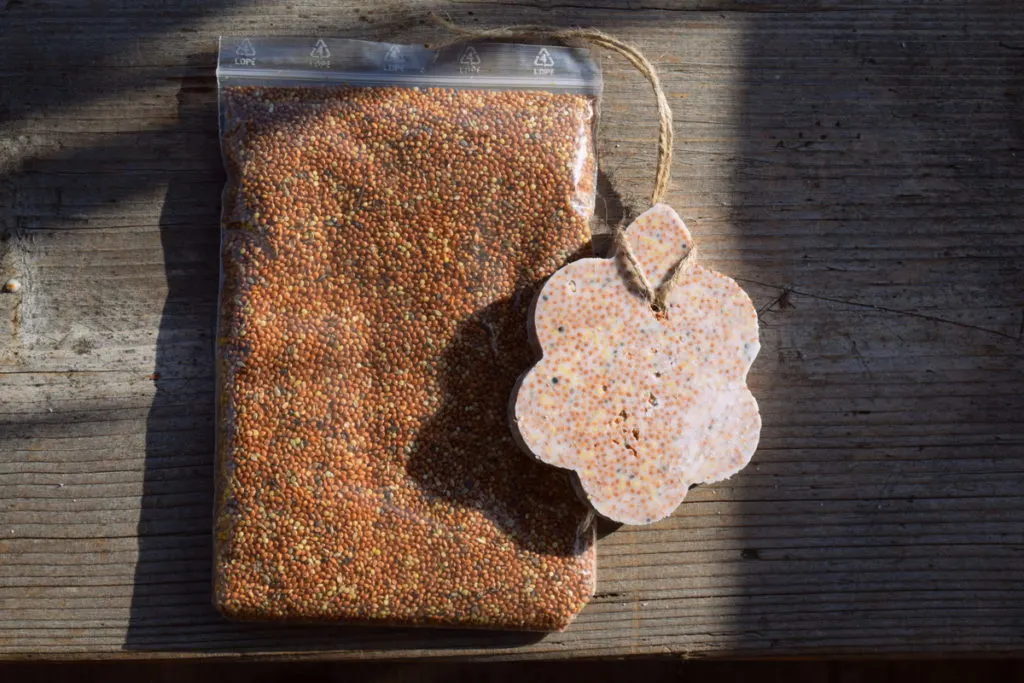
Make it a win-win situation, by providing the over-wintering birds just what they need to survive and nothing more. I am referring to questionable ingredients that are often included in many birdseed ornaments. We will get into this misinformation later, but first, find out all you need to get started.
Pin This For Later
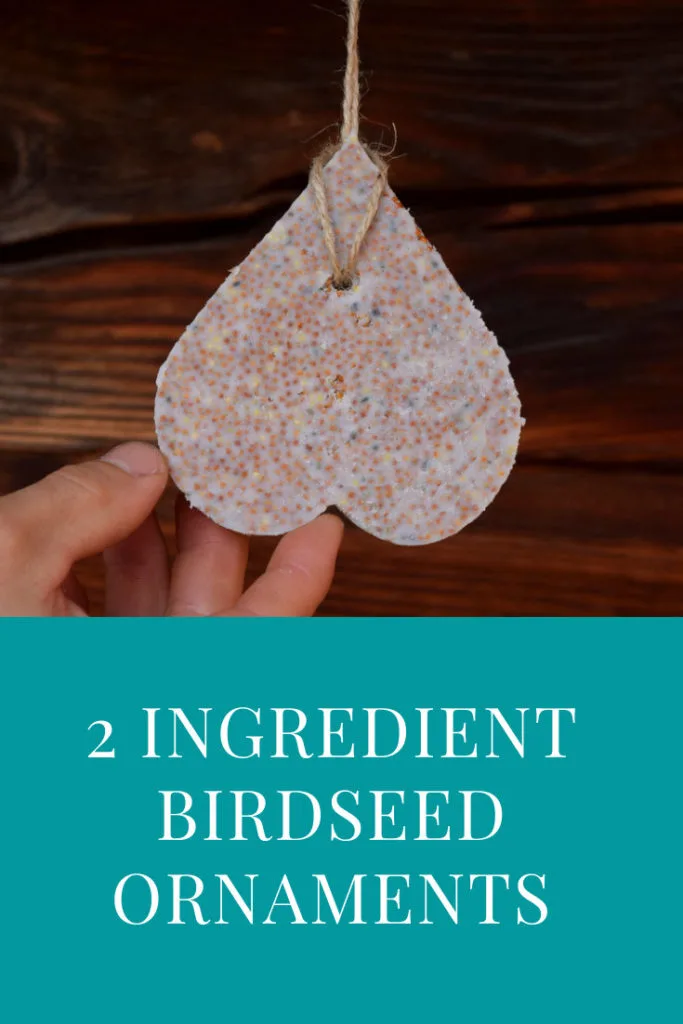
2 ingredients for your birdseed ornaments
Tallow, also called suet, and bird seeds are the only two ingredients you will need to make these simple birdseed ornaments.
If you’ve already learned how to render your own tallow, that’s great! The world could benefit from more self-reliant learners like you.
If you haven’t mustered up the courage to try rendering beef fat yet, you will still be able to buy some tallow from your local butcher. You can always purchase tallow online.
As far as bird seeds go, feel free to use whatever seed mix you already put out for the birds. You can also ask other bird-feeding enthusiasts what they use.
Mostly, this will be a mixture of millet and hulled sunflower seeds.
Finches, sparrows and other songbirds prefer to eat smaller seeds, so refrain from adding milo (sorghum) to your ornaments.
Where to buy birdseed?
You can often find birdseed at a hardware or farm store, as well as in pet shops. Of course, you can always buy a pre-made wild bird seed mixture online for a superior treat.
Items needed to make birdseed ornaments
Before getting your hands covered in tallow (don’t worry, it makes a great moisturizer!) you should set out everything you need.
- birdseed
- tallow in a pot
- bowls
- spoon
- branches or paper straws (one for each ornament)
- baking sheet
- metal ornaments or egg molds
- twine
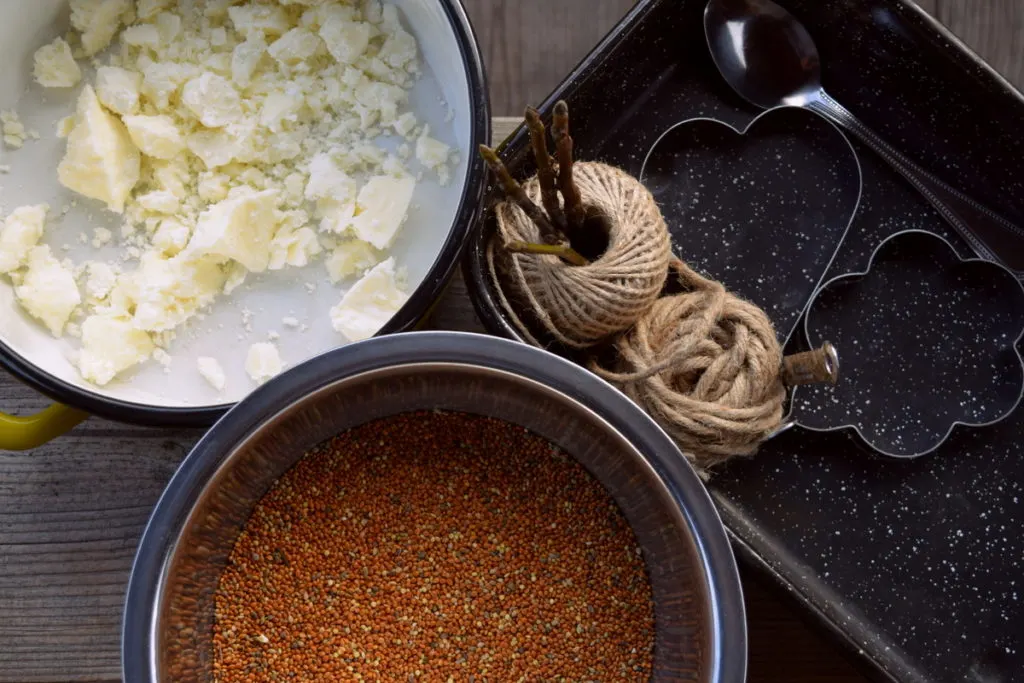
How much seed and tallow you will need depends greatly on how many birdseed ornaments you wish to make at once.
The easiest way to figure out how much birdseed you need is to set out your cookie cutters or egg molds, and fill them with dry birdseed in a baking sheet. Fill them nearly to the rim.
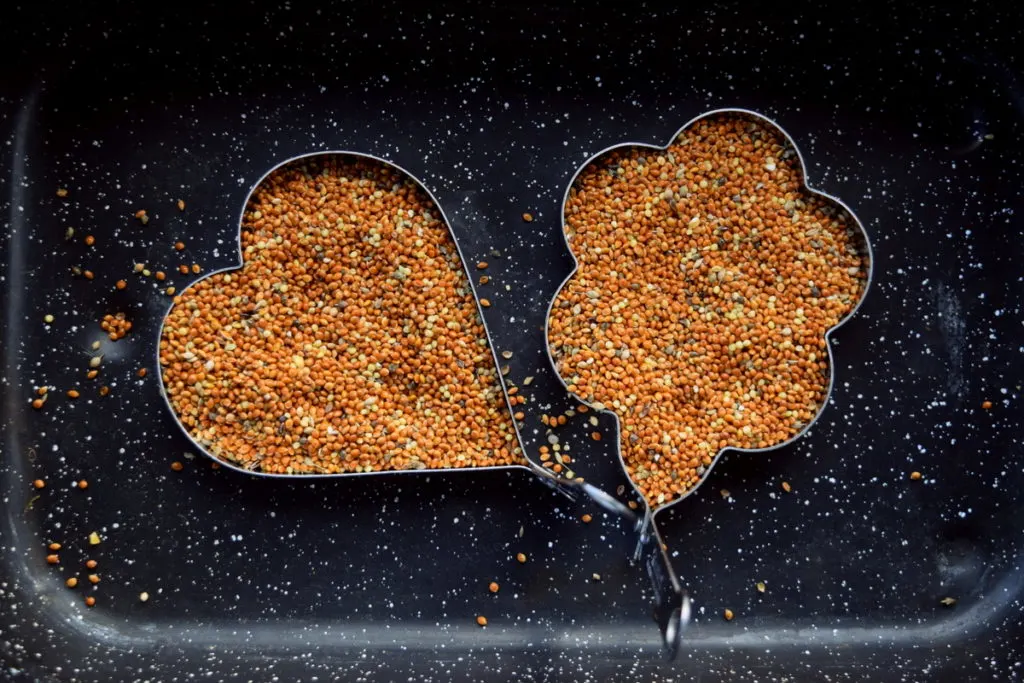
Then, pour this “measured” amount of birdseed into a separate bowl.
As for the tallow, you need enough to thoroughly cover the seeds.
If there is too little, the ornaments will be crumbly. Too much and the ornaments will be too hard. Different seed mixes will also take more or less fat. It is all a matter of experimentation.
Step-by-step: putting it all together
Having recently made some birdseed ornaments of our own, after rendering an extremely large batch of tallow, we found what works well – and what doesn’t.
It is often worthwhile to mention what worked less well, so here it is.
Following the path of others, we poured melted tallow into the birdseed and stirred it as quickly as we could.
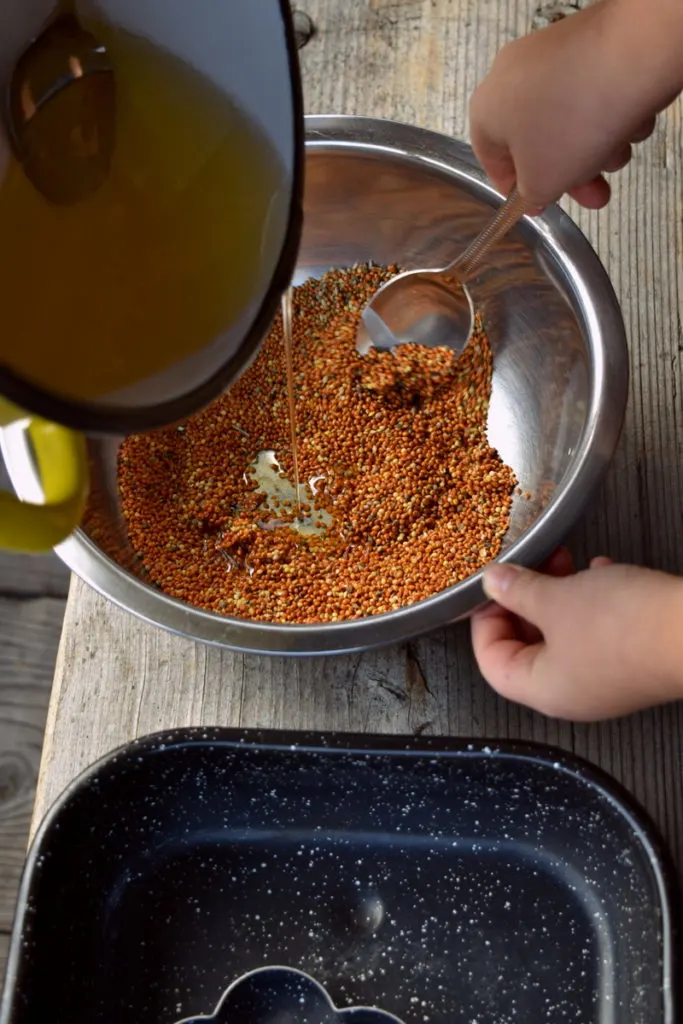
The end result was that the tallow cooled too quickly – and, consequently, it was not enough for the ornaments to set properly.
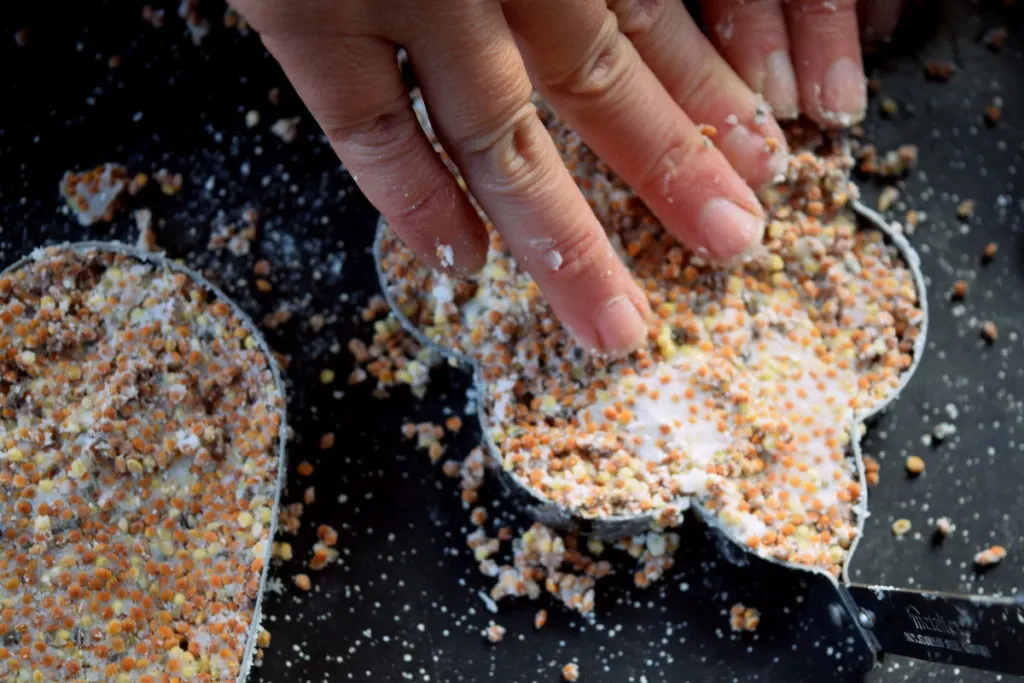
Not a big loss, rather a useful learning experience.
To correct for this, we crumbled the tallow-covered birdseed and added it back to a warm pot of tallow and stirred it well.
Filling the birdseed ornaments
Rather than using our hands to stuff the egg molds with birdseed, we were now able to spoon out the seeds with plenty of tallow to keep everything stuck together.
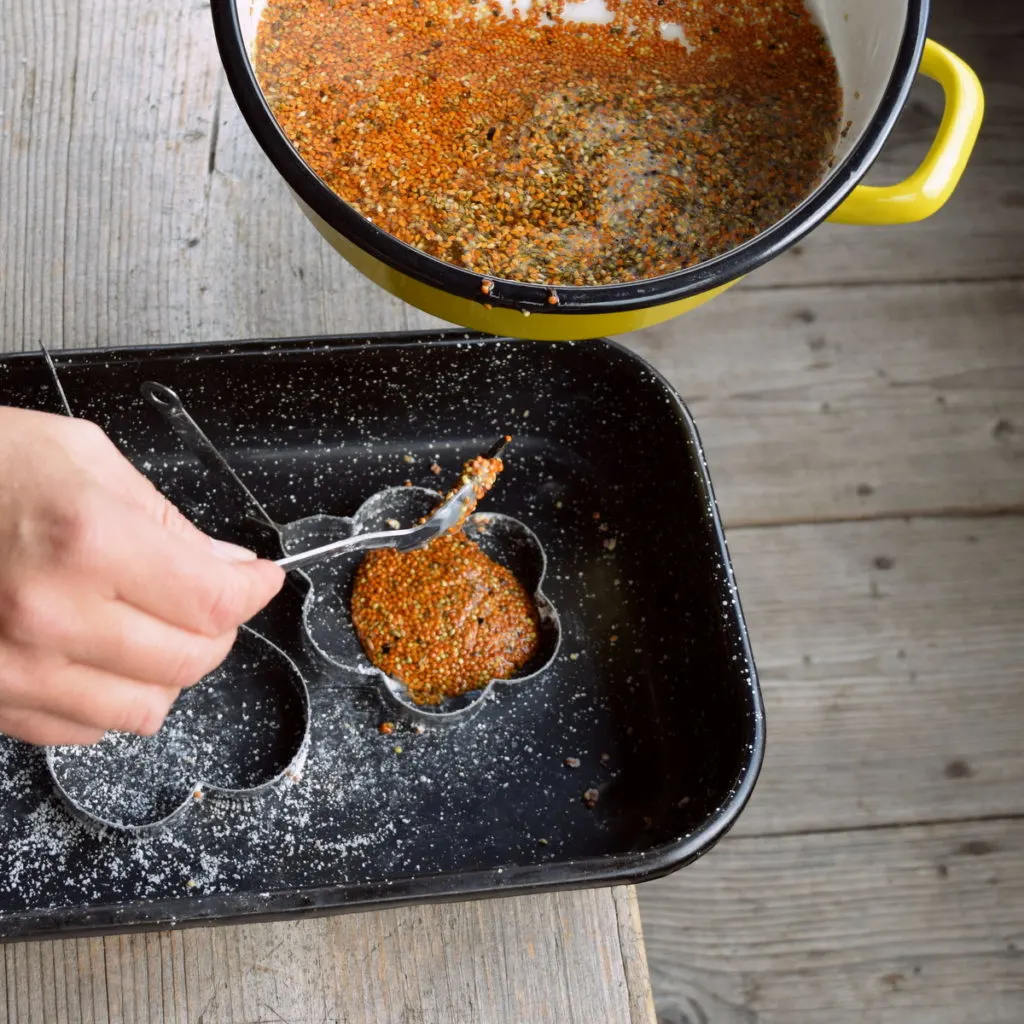
Be sure to fill your molds to the rim. If you are using old cookie cutters, you can even leave the birdseed/tallow mixture in them and hang them in the trees as is, frame and all!
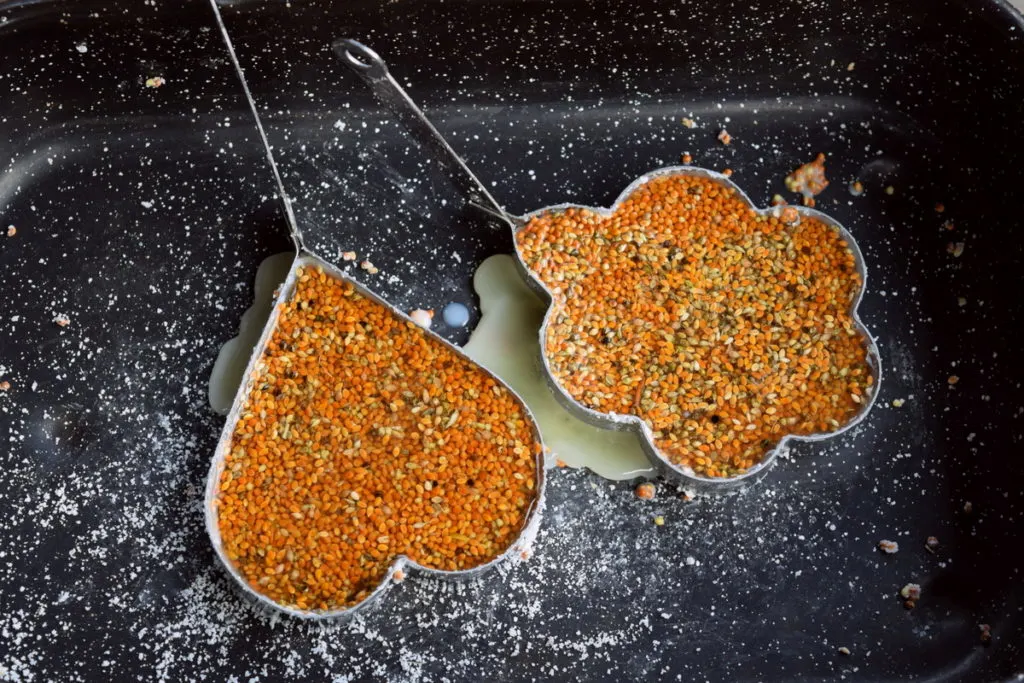
Making a hole to hang them by
As the tallow begins to harden, you can press a branch down to the bottom of the baking sheet to make a hole.
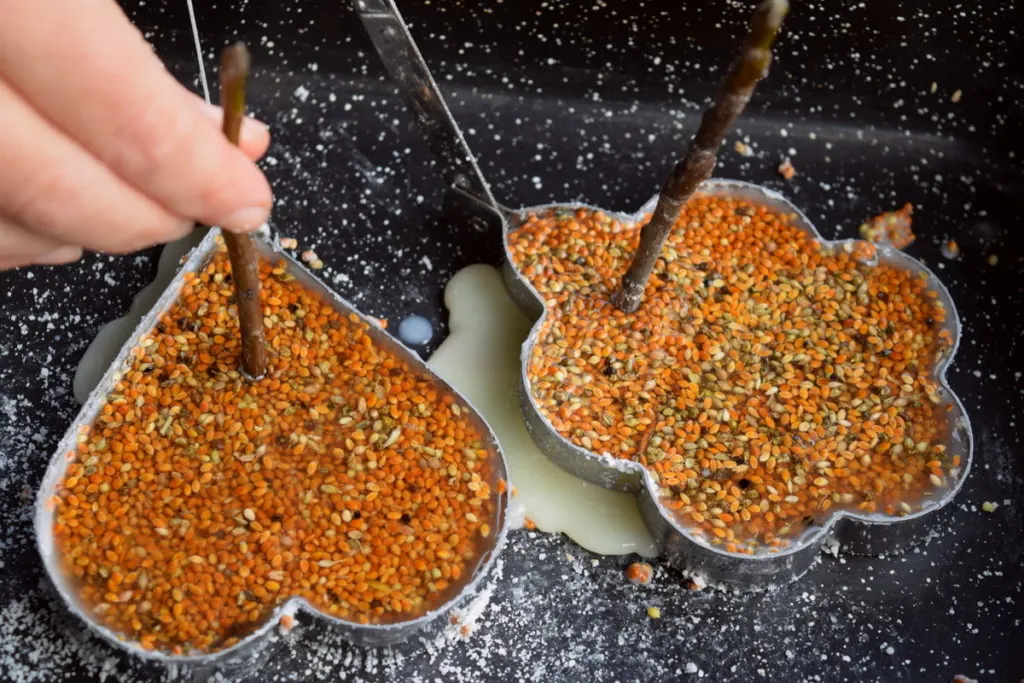
Once the ornament has hardened, it can easily be removed, along with the mold. Gently push it out with your fingers.
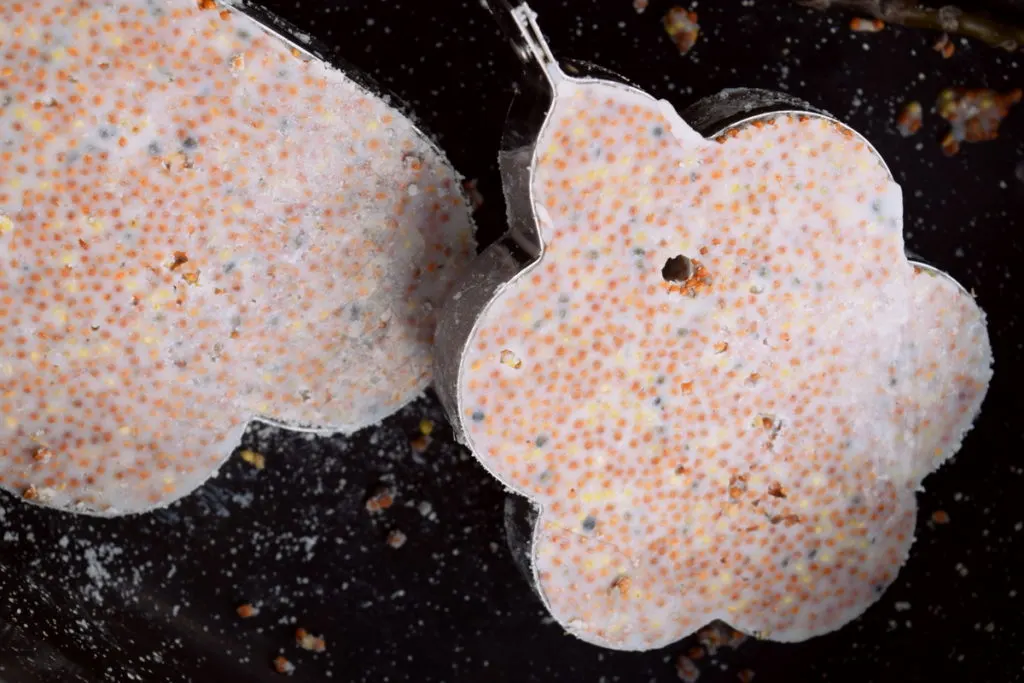
If you are in a rush, you can put the entire baking sheet in the fridge or freezer. Your ornaments will be ready in a matter of minutes.
You can also make them outside on an almost-winter day to achieve the same effect.
In any case, they should be ready to hang in 1-2 hours. Slide a piece of twine through the hole and hang it outside for the birds to discover.
If you have leftover birdseed and tallow mixture
If you happen to have extra pine cones laying around, there are several ways to put them to good use.
Making bird feeders is one of them.
While the tallow is still warm, dip your pine cones or spruce cones in the seedy mix, making sure it gets in every groove.
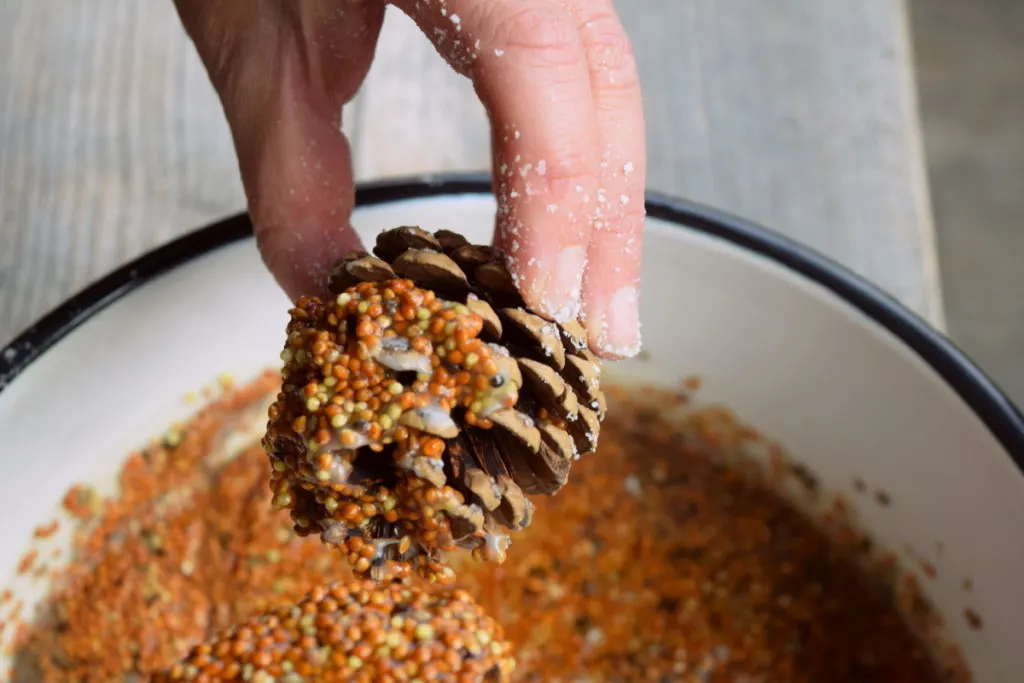
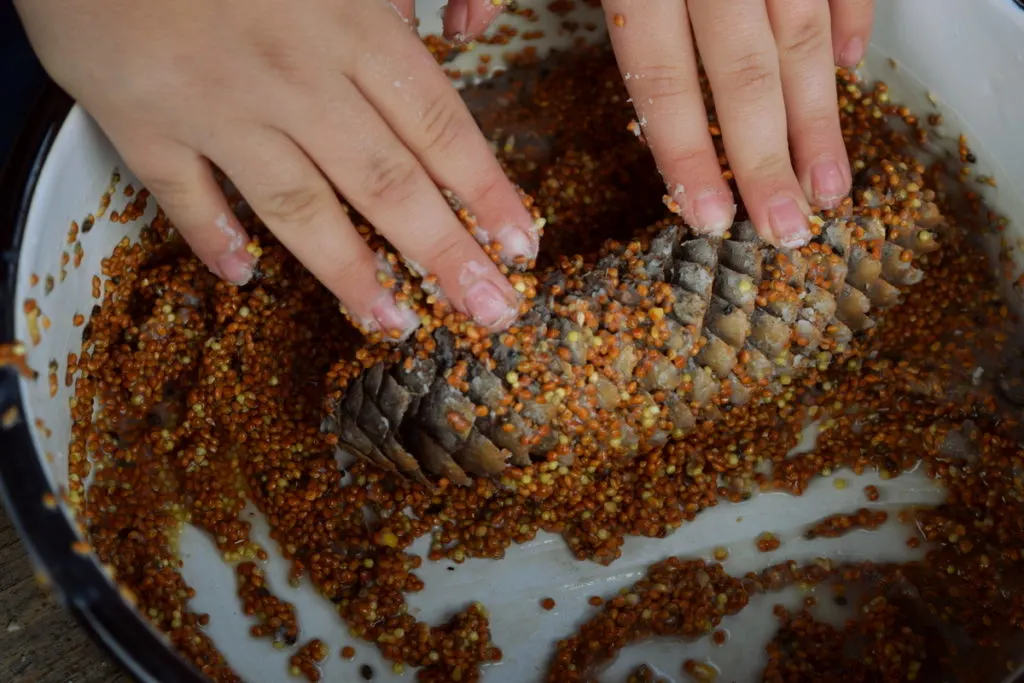
Tie with a string and hang in a tree for the birds to dine.
Tips for hanging your birdseed ornaments
These simple birdseed ornaments are meant to be hung when the outdoor temperatures are hovering near freezing.
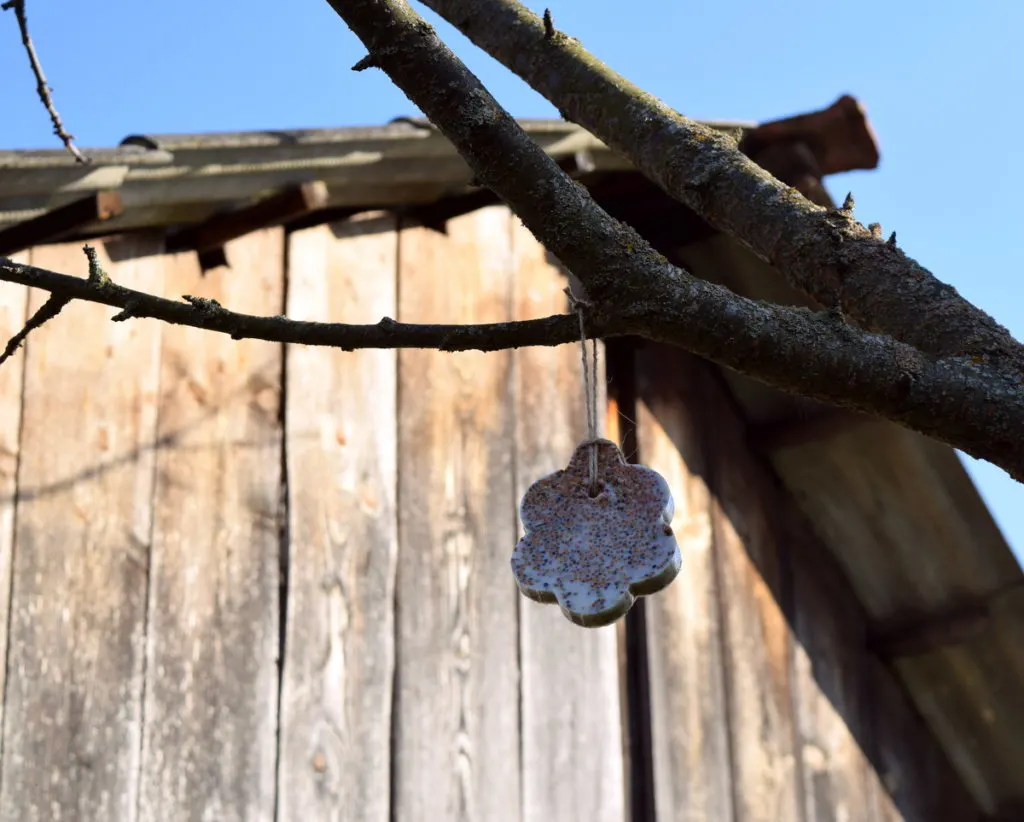
Never hang them in warm weather, as the fat can then rub off on the birds’ feathers, causing more than a sticky situation.
If you find that things are getting pretty messy, you can always make a square block of this same birdseed and tallow mixture to insert into a suet cage.
The point of feeding birds during the lean months, should always be to ensure their survival, not just to attract them to your garden for entertainment purposes. That being said, if you have fruit trees, do not pick every single apple, plum or pear for yourself – always leave aplenty for nature’s pantry too.
You may want to go light on the yard work and leave some autumn leaves on the ground as well. This provides birds with a winter place to forage for food.
Hanging your birdseed ornaments where you can see them – or not
If you have a large property, you may want to put some ornaments closer to home, and some further away, far from your sight. Leaving the birds a chance to decide how close they wish to come to your home.
In the case of a smaller property or backyard, these tallow birdseed ornaments can be hung from low-hanging branches near a building.
Those living in a city are not exempt from the joys of attracting birds. Birdseed ornaments can be hung on balconies or on overhangs close (but not too close) to a window.
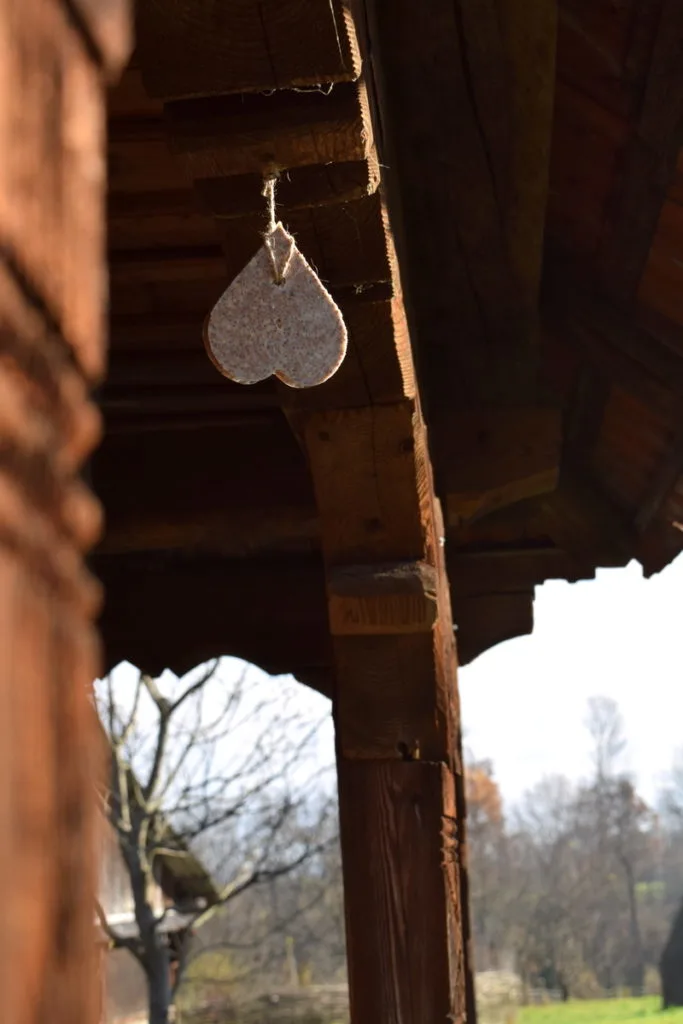
For starters, make a trial set of two or three, to see what the birds in your area like.
Perhaps they would like a pine cone coated in birdseed?
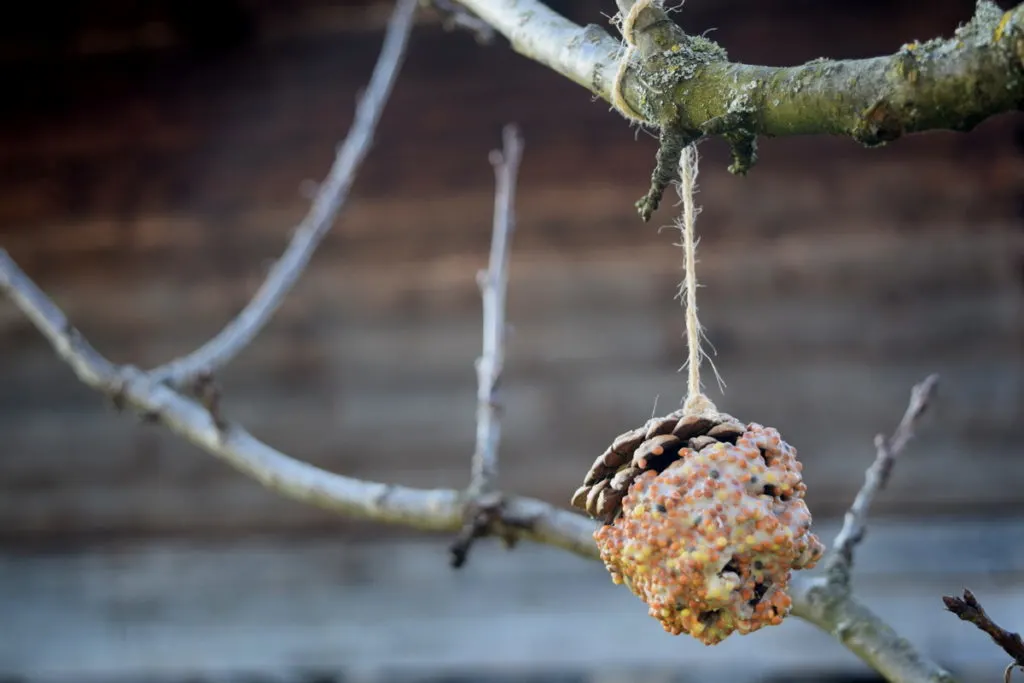
These are even easier to make with peanut butter and seeds. No tallow required.
Related reading: 9 Clever and Practical Pine Cone Uses in the Home and Garden
What not to put in your birdseed ornaments
Wild and fine feathered friends across the world are scavengers – of insects, seeds, the occasional nuts and berries.
However, you will find many “birdseed ornaments” recipes out there, telling you to add flour, coconut oil, sugar or corn syrup, the grease of industrially processed bacon and the like.
All of these items are not naturally occurring in a bird’s diet and should be left out of your healthy homemade birdseed ornaments.
Destroying their diets as well as removing significant places in their habitat will only decrease their overall numbers or harm their health, as it causes an even greater imbalance in the ecosystem. For many of the same reasons that you should not be feeding ducks bread, or crackers, please omit non-nourishing gluten-based products for the rest of the birds too.
If you feel the need to add further ingredients, be sure to use organic peanut butter or dried meal worms. After all, the birds really do deserve the very best!
An additional ingredient to keep the squirrels away
We have surprisingly few squirrels where we live, and secretly wish there were more. Along with bats, owls, beavers and foxes too.
Rewilding is often a hot topic to bring up around a communal dinner table, as there are those all in favor, with the other side being opposed to letting wild animals roam in “our” space.
In the end, it is all about balance.
So, if the squirrels or chipmunks are in direct competition with the birds, it is time to give the winged flyers a slight advantage.
It is said that when you add red pepper flakes to the suet, all it takes is a hearty bite for the squirrels not to come back, without harming the birds in the process.
Use this extra ingredient only when absolutely necessary to ensure that the birds get the best catch of the day.
Don’t forget that birdwatching can be fun and educational for all ages.
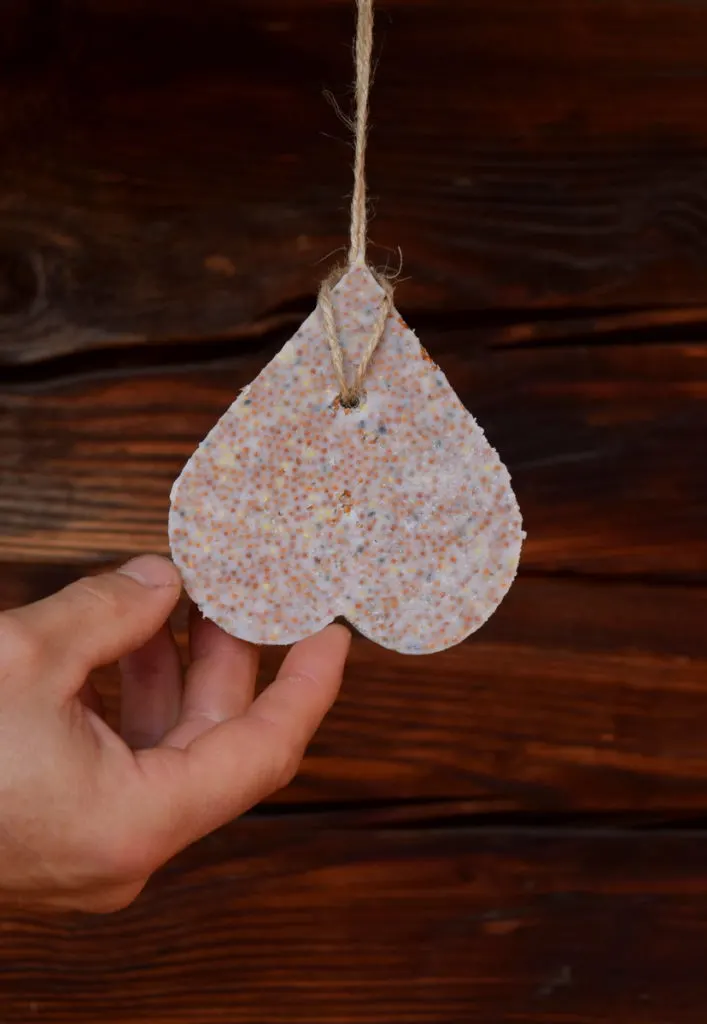
Encourage kids to get in on the birdseed ornament making action. Let them get their hands dirty, then see who can spot the first bird to the feeder. Watch the bird feeding together for some extra-special family time.
At the same time you can learn to identify your local birds and find out what to plant next in your garden to support their vital existence.

Get the famous Rural Sprout newsletter delivered to your inbox.
Including Sunday ramblings from our editor, Tracey, as well as “What’s Up Wednesday” our roundup of what’s in season and new article updates and alerts.


